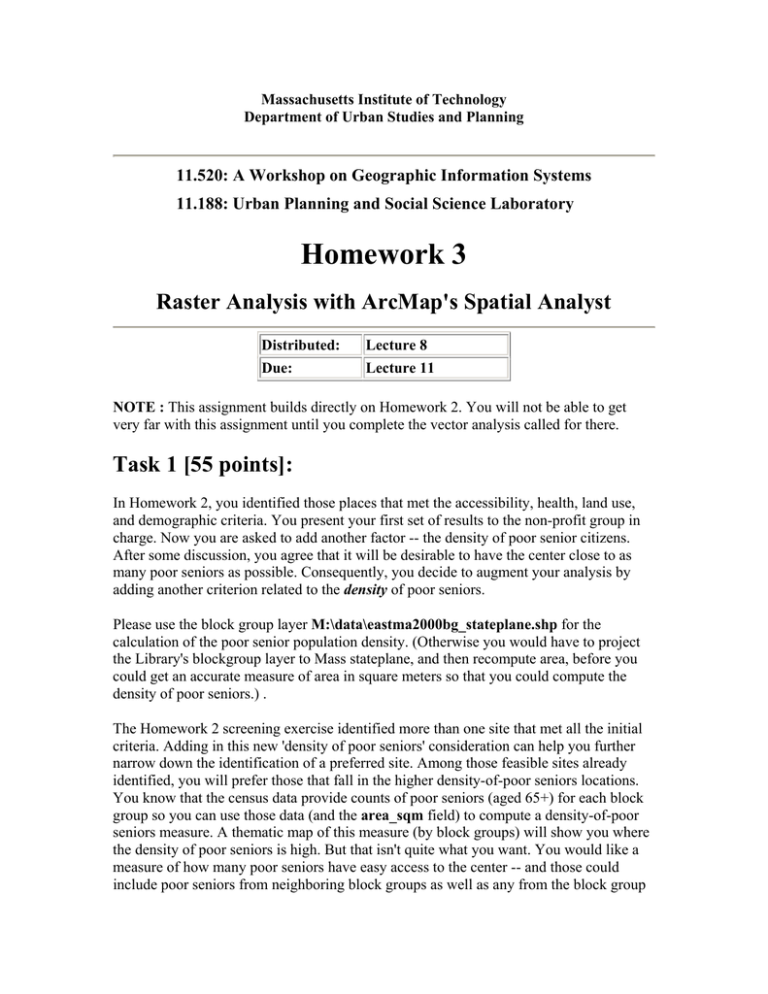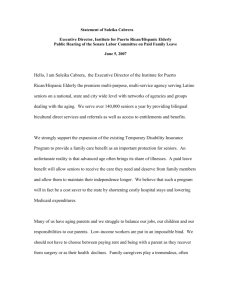11.520: A Workshop on Geographic Information Systems
advertisement

Massachusetts Institute of Technology Department of Urban Studies and Planning 11.520: A Workshop on Geographic Information Systems 11.188: Urban Planning and Social Science Laboratory Homework 3 Raster Analysis with ArcMap's Spatial Analyst Distributed: Lecture 8 Due: Lecture 11 NOTE : This assignment builds directly on Homework 2. You will not be able to get very far with this assignment until you complete the vector analysis called for there. Task 1 [55 points]: In Homework 2, you identified those places that met the accessibility, health, land use, and demographic criteria. You present your first set of results to the non-profit group in charge. Now you are asked to add another factor -- the density of poor senior citizens. After some discussion, you agree that it will be desirable to have the center close to as many poor seniors as possible. Consequently, you decide to augment your analysis by adding another criterion related to the density of poor seniors. Please use the block group layer M:\data\eastma2000bg_stateplane.shp for the calculation of the poor senior population density. (Otherwise you would have to project the Library's blockgroup layer to Mass stateplane, and then recompute area, before you could get an accurate measure of area in square meters so that you could compute the density of poor seniors.) . The Homework 2 screening exercise identified more than one site that met all the initial criteria. Adding in this new 'density of poor seniors' consideration can help you further narrow down the identification of a preferred site. Among those feasible sites already identified, you will prefer those that fall in the higher density-of-poor seniors locations. You know that the census data provide counts of poor seniors (aged 65+) for each block group so you can use those data (and the area_sqm field) to compute a density-of-poor seniors measure. A thematic map of this measure (by block groups) will show you where the density of poor seniors is high. But that isn't quite what you want. You would like a measure of how many poor seniors have easy access to the center -- and those could include poor seniors from neighboring block groups as well as any from the block group in which the center is located. So, you decide to use ArcMap's Spatial Analyst tools that you've learned to develop a better measure. First, you'll create a rasterized (grid) version of the block groups (with the block group poor senior citizen density as the cell value). Then you can use the 'neighborhood statistics' tools to create a new grid layer that has, for its cell value, the average of all the cells within some buffer distance (a circle of 1000 meter radius is what we suggest below). To follow through on this idea, create a grid coverage that rasterizes the block groups into grid cells that are 100 meters on edge. Be sure to mask off all but the 5-town area when you create the grid coverage. Set the value in each cell to be your estimate of the density of poor seniors in the block group at the center of the grid cell. Create a thematic map showing the density of poor senior citizens across your Cambridge grid cells. Hints: • Compute the poor senior density as the count of poor senior citizens per block group divided by the area_sqm column. Note that area_sqm is in square meters - not in acre. (Recall that 1 hectare = 10,000 square meters = 2.471 acres, and 1 acre = 43,560 square feet.) You can join this new table to the original block group coverage before rasterizing it so that you can use your newly computed density to set the value of each grid cell. • Consider carefully which values from the census you should use for calculating poor seniors per block group. Pay close attention to the universe of the senior poverty measure you used in Homework 2. Is there a better measure you should use? Make sure to document your choice in your assignment. Now, use the Spatial Analyst > Neighborhood Statistics option to generate a new grid layer where the value of each grid cell is the average (mean) of the density of poor seniors in the grid cells. Define the neighborhood to be a circle (of grid cells) of 1000meter radius centered on each grid cell. Notice how the new layer is different from the original rasterization of your block group densities. Now, intersect this smoothed density-of-poor seniors layer with the set of suitable locations that you identified using all of the criteria stated in Homework 2. One way to select a specific location for the poor senior center would be to pick the (1 hectare) site among the acceptable locations from Homework 2 that had the highest density of nearby poor seniors. Add another view to the layout of the thematic map you just created which shows this neighborhood averaging of density of poor seniors. Annotate this layout showing both densities: before and after neighborhood averaging. Summary of Task 1 Requirements: Turn in one map layout with two views -- one showing the block group density-ofpoor seniors before the neighborhood averaging and one showing the density-of- poor seniors after the neighborhood averaging. Adjust and annotate the map so it is readable and add a few sentences explaining what each map is measuring and commenting on any shift in pattern that you observe. As in Homework 2, you will be graded on the quality of both your analysis and your presentation of your results. What to Make of All This: Task 1 asks for one map with two views (of the block group poor senior density before and after neighborhood averaging). Make sure that the neighborhood average view includes some visual representation (i.e. visual overlay) of the HW #2 acceptable sites so the reader can see which high-density cells fall within the HW #2-acceptable locations. Doing this is more a matter of attention to cartography and visual display rather than computing a new combined index. • A visual overlay of the HW #2-suitable areas and the neighborhood-densitysurface is sufficient to let you identify which HW #2-sites are located in places that are high on the neighborhood-density-of-poor seniors surface (hereafter "ndpoor senior-surface"). By a "visual overlay" we mean placing the outline of the vector layer over the raster layer in an ArcMap window so it is possible to visually inspect the relationship among the layers. Task 2 [45 points]: While our formulation of the problem does narrow down the number of possible site locations, many of the criteria were rather arbitrary -- why within 300 meters of a major road instead of 200 or 500 meters? In general, you will want to do some reasoning and make some judgments about how to balance (or adjust!) the various criteria that you have incorporated into your site selection screening process. Write a short report (maximum of 2 double-spaced pages, 10-point font, 1-inch margins) interpreting the results of your analysis and explaining any comments you may have about the allowable locations. Do you agree with the highest density location picked in Task 1? Would you prefer to relax one of the other criteria and shift the site elsewhere? Would you suggest some tradeoffs among the criteria? Do the criteria restrict the sites a lot or a little? Do they appear to capture the individual criteria reasonably? There are not 'correct' answers to these questions -- and we do not expect you to research the many real-life characteristics of Cambridge that could influence your decision. The intent is for you to back away from ArcMap and GIS and spend some time reflecting on the problem of locating a poor senior center and thinking about how your specific variables, cutoffs, and visualization tools may have biases, artificial limits, or otherwise colored or overlooked relevant factors. Why do you think you have (or have not) zeroed in on one or more sensible suggestions for where to put the center? Recognize in Task 2 that we are not trying to get you to pick a 'best' location. Rather we want you to use the data and GIS tools to boil down the many criteria and possible sites to a reasonable and informed discussion of the pluses and minuses of several specific sites and the primary criteria and tradeoffs that are likely to be involved in making the selection. You'll want to be able to refer to your Task-1 map in your discussion and it will be easier to make your points if your maps help the reader visualize the spatial patterns (in terms of buffers, land use density, etc.) that you've identified for the various criteria. Finally, notice that we've simplified the site selection task to ignore the cost of acquiring the property. Write a few sentences explaining how such cost considerations might steer the site selection toward one or another of the better locations that your analysis identified and what further analysis you might do (using GIS tools and data of the kinds we've been using) to sort through this question. You do not actually have to perform this analysis -- just indicate how you would approach it. You are welcome to reference your answer from HW # 2, but you should amplify on how the additional work in HW # 3 (this assignment) augmented your analysis. Additional comments regarding how to 'intersect' your new smoothed neighborhood-density-of-poor seniors layer with those suitable sites that you identified in HW #2: It is possible, but not easy, to develop meaningful metrics that combine the two into a single suitability index. First, the HW #2 suitable sites are in vector format and the ndpoor senior-surface is in raster format. You would have to convert one or another before overlaying them computationally. You could rasterize the HW #2 sites and then combine that layer with the nd-poor senior surface. E.g., you could assign a value of 0 or 1 to the HW #2-rasterized cells depending upon whether a cell-center is within an acceptable region. Combining that layer with the nd-poor senior-surface layer would exclude nonfeasible high-density-poor senior cells -- thereby helping you identify the HW #2-suitable sites that had high density. But we are concerned that doing this would (a) take more time than we want you to spend, and (b) be counterproductive by incorrectly suggesting that the numerical result provides a useful index for determining the 'best' location. On this point, note that the HW #2 sites are based on meeting constraints -- within xxx feet of a major road, far from a TRI site, etc. But the 'density of poor seniors' factor is treated as a continuous scale -- the density resulting from your neighborhood averaging computation. Picking the highest density location that meets the other constraints is certainly a reasonable strategy but hardly the only way of making a choice. You could, instead, turn the density factor into a threshold constraint (at least yyy/sqm...) and make another factor -- for example the distance-to-road factor -- into a continuous variable so the 'best' site was one satisfying all the other constraints (including poor senior density) and closest to a major road.


